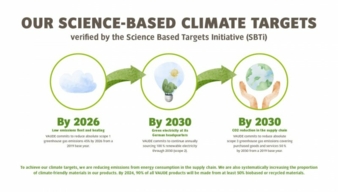19/01/2023 – Sustainability — auf Deutsch lesen
SBTi verifies Vaude’s 1.5 degree climate targets
The Science Based Targets Initiative (SBTi) confirmed that Vaude’s planned targets for reducing greenhouse gas emissions are in line with the 1.5 degree target.
Since January 1, 2022, all Vaude products are made with climate-neutral manufacturing. This milestone, which is initially still being achieved through offsets, is part of Vaude’s ambitious climate strategy, the concrete targets of which have now been scientifically verified and published. This means that Vaude has the certainty of achieving a reduction in global warming in compliance with the 1.5 degree target with its climate goals.
This was calculated and verified by the scientists of SBTi using the worldwide Vaude carbon footprint in accordance with the Greenhouse Gas Protocol in a complex process. “This is an important confirmation of our commitment to fighting climate change that shows us: It’s really possible! If we all do our part, we can still slow down global warming, which acutely threatens life on earth. At the same time, the current climate crisis is making it clear how important it is to move away from fossil fuels. It’s high time,” appeals Antje von Dewitz, Vaude Managing Director.
Vaude climate targets confirmed and published
In October, the SBTi confirmed that Vaude’s planned targets for reducing greenhouse gas emissions are in line with the 1.5 degree target. Three specific targets were verified and published:
1. Vaude is committed to a reduction of 45% in its Absolute Scope 1 greenhouse gas emissions by 2026, using 2019 as the base year.
2. Vaude is committed to continuing to source 100% of its electricity from renewable sources annually until 2030.
3. Vaude is committed to a reduction of 50% in its Absolute Scope 3 greenhouse gas emissions for purchased goods and services by 2030, using 2019 as the base year.
The biggest challenge: The global supply chain
The biggest challenge for Vaude is the third target: cutting emissions in the upstream supply chain in half by 2030. This is where the lion’s share of emissions is generated, the effort is also the highest and implementation the most difficult. This is because it involves complex, multi-level supply chains with approximately 100 material suppliers all over the world. “Recording all the energy consumption of all the partners involved was already a mammoth task. But now we have a sound data basis on which we can measurably reduce our global emissions,” explains Vaude Sustainability Manager Hilke Patzwall. The focus here is on the transition to renewable energies and the use of resource-conserving materials in the manufacturing process. The production of materials in particular consumes a great deal of energy, most of which comes from fossil fuels.
To reduce emissions in the global supply chain, Vaude set itself two major subgoals. By 2024, over 90% of our products will be made primarily from recycled or biobased materials. Vaude has also set itself the goal of cutting emissions from the supply chain in half by 2030, especially at material manufacturer facilities.
What has Vaude already achieved and what’s next?
In the Vaude Winter Collection 23/24, 72% of the products already have a recycled or biobased material content of at least 50%. Since January 2022, Vaude has been climate neutral with all products worldwide. Since Vaude cannot eliminate all emissions immediately due to the enormous challenges in its own processes and complex supply chains, the company has chosen to take an intermediate step. Vaude is both investing in the reduction of CO2 emissions and in the compensation of the (currently) unavoidable emissions via a myclimate Gold Standard carbon offset project in Vietnam.
Vaude will reduce its emissions in accordance with the verified climate targets in the defined period in order to ensure permanent compliance with the 1.5 degree target. The agreed upon subgoals and objectives will be regularly reviewed by the SBTi experts.
- The Science Based Targets Initiative (SBTi): The international Science Based Targets Initiative is committed to ensuring that the corporate sector contributes to the climate targets adopted in Paris. Companies voluntarily commit themselves to science-based climate targets that are in line with the requirements of the Paris Agreement to limit global warming to 1.5 °C. Within the initiative, the following international organizations are cooperating: The CDP (Disclosure Insight Action), UN Global Compact, World Resources Institute (WRI) and the World Wide Fund for Nature (WWF).





